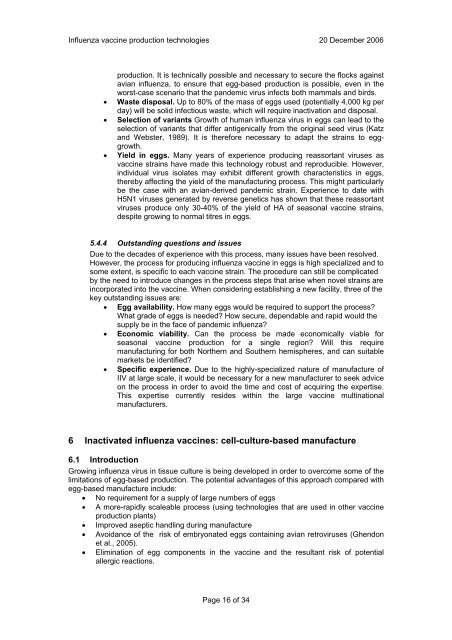A review of production technologies for ... - World Health Organization
A review of production technologies for ... - World Health Organization
A review of production technologies for ... - World Health Organization
You also want an ePaper? Increase the reach of your titles
YUMPU automatically turns print PDFs into web optimized ePapers that Google loves.
Influenza vaccine <strong>production</strong> <strong>technologies</strong> 20 December 2006<br />
<strong>production</strong>. It is technically possible and necessary to secure the flocks against<br />
avian influenza, to ensure that egg-based <strong>production</strong> is possible, even in the<br />
worst-case scenario that the pandemic virus infects both mammals and birds.<br />
• Waste disposal. Up to 80% <strong>of</strong> the mass <strong>of</strong> eggs used (potentially 4,000 kg per<br />
day) will be solid infectious waste, which will require inactivation and disposal.<br />
• Selection <strong>of</strong> variants Growth <strong>of</strong> human influenza virus in eggs can lead to the<br />
selection <strong>of</strong> variants that differ antigenically from the original seed virus (Katz<br />
and Webster, 1989). It is there<strong>for</strong>e necessary to adapt the strains to egggrowth.<br />
• Yield in eggs. Many years <strong>of</strong> experience producing reassortant viruses as<br />
vaccine strains have made this technology robust and reproducible. However,<br />
individual virus isolates may exhibit different growth characteristics in eggs,<br />
thereby affecting the yield <strong>of</strong> the manufacturing process. This might particularly<br />
be the case with an avian-derived pandemic strain. Experience to date with<br />
H5N1 viruses generated by reverse genetics has shown that these reassortant<br />
viruses produce only 30-40% <strong>of</strong> the yield <strong>of</strong> HA <strong>of</strong> seasonal vaccine strains,<br />
despite growing to normal titres in eggs.<br />
5.4.4 Outstanding questions and issues<br />
Due to the decades <strong>of</strong> experience with this process, many issues have been resolved.<br />
However, the process <strong>for</strong> producing influenza vaccine in eggs is high specialized and to<br />
some extent, is specific to each vaccine strain. The procedure can still be complicated<br />
by the need to introduce changes in the process steps that arise when novel strains are<br />
incorporated into the vaccine. When considering establishing a new facility, three <strong>of</strong> the<br />
key outstanding issues are:<br />
• Egg availability. How many eggs would be required to support the process?<br />
What grade <strong>of</strong> eggs is needed? How secure, dependable and rapid would the<br />
supply be in the face <strong>of</strong> pandemic influenza?<br />
• Economic viability. Can the process be made economically viable <strong>for</strong><br />
seasonal vaccine <strong>production</strong> <strong>for</strong> a single region? Will this require<br />
manufacturing <strong>for</strong> both Northern and Southern hemispheres, and can suitable<br />
markets be identified?<br />
• Specific experience. Due to the highly-specialized nature <strong>of</strong> manufacture <strong>of</strong><br />
IIV at large scale, it would be necessary <strong>for</strong> a new manufacturer to seek advice<br />
on the process in order to avoid the time and cost <strong>of</strong> acquiring the expertise.<br />
This expertise currently resides within the large vaccine multinational<br />
manufacturers.<br />
6 Inactivated influenza vaccines: cell-culture-based manufacture<br />
6.1 Introduction<br />
Growing influenza virus in tissue culture is being developed in order to overcome some <strong>of</strong> the<br />
limitations <strong>of</strong> egg-based <strong>production</strong>. The potential advantages <strong>of</strong> this approach compared with<br />
egg-based manufacture include:<br />
• No requirement <strong>for</strong> a supply <strong>of</strong> large numbers <strong>of</strong> eggs<br />
• A more-rapidly scaleable process (using <strong>technologies</strong> that are used in other vaccine<br />
<strong>production</strong> plants)<br />
• Improved aseptic handling during manufacture<br />
• Avoidance <strong>of</strong> the risk <strong>of</strong> embryonated eggs containing avian retroviruses (Ghendon<br />
et al., 2005).<br />
• Elimination <strong>of</strong> egg components in the vaccine and the resultant risk <strong>of</strong> potential<br />
allergic reactions.<br />
Page 16 <strong>of</strong> 34

















